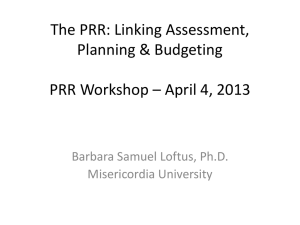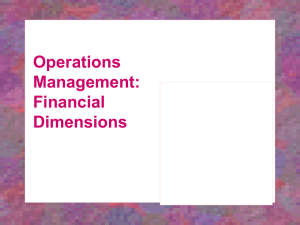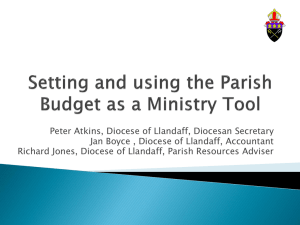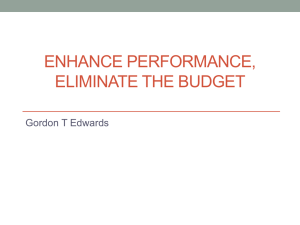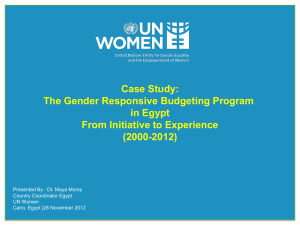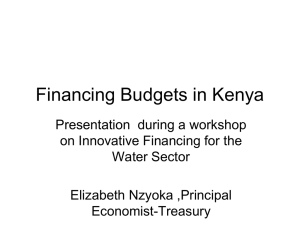Introduction to Budgeting and Forecasting at the UofC
advertisement
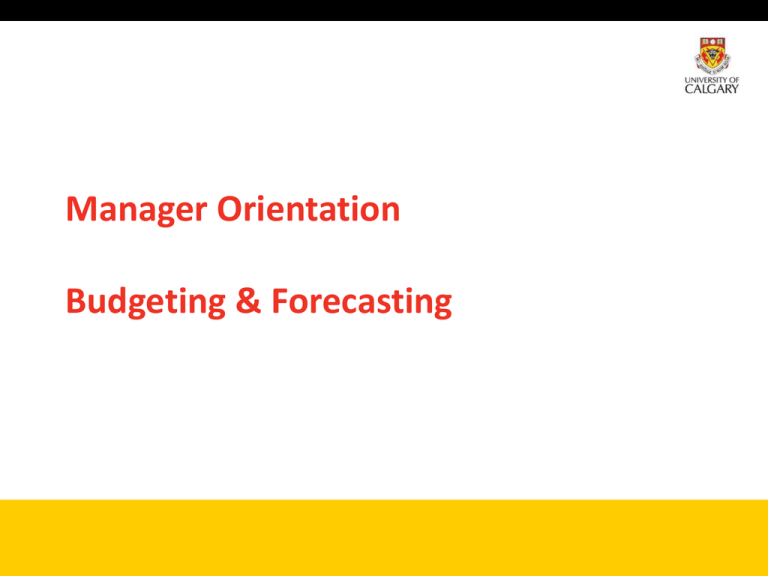
Manager Orientation Budgeting & Forecasting Today’s Agenda New Budget Model Principles Overview of budgeting and forecasting Timelines How the Funds work Role of Financial Planning & Analysis Overview of capital budgeting Introduction to budgeting and forecasting models UFundamentals 2 Objectives 1. Introduction to the Budgeting Principles 2. Gain an understanding of the budgeting and forecast process. 3. Define the responsibilities of a budget owners in the budgeting and forecasting process. 4. Be aware of the budgeting and forecasting timelines. 5. Introduction to the various budgeting and forecast models UFundamentals 3 Budget Model Principles One university family Alignment with vision and priorities Mindfulness Accountability Transparency Financial sustainability Flexibility and entrepreneurialism Incentives UFundamentals New Budget Model Principles: Align human, financial, and capital resource allocations decisions with Eyes High / provincial results-based budgeting 4 4 Budgeting A budget is the plan developed by an organization as its benchmark to achieve its financial goals and objectives for a period of time – generally for one year at a time. Project budgets often span more than a single year. Changes to a budget occur in the form of a forecast. UFundamentals 5 Purpose of Budgeting Provides a benchmark for evaluating financial performance against the goals and objectives. Helps an organization allocate financial resources. A communication tool used to expresses financial goals and objectives of the organization. UFundamentals 6 What is Forecasting? Forecasting is: the change in the future financial expectation from the original budget usually as result of new information. a process of estimation to predict our financial results by using current and historical information. performed monthly to incorporate changes in expectations such as delayed hiring or purchase of materials. UFundamentals 7 Purpose of Forecasting A tool that provides information to help make prudent business decisions and to understand the financial results and health of an organization. Helps to identify unexpected issues or new information so that decisions for corrective action can be made. Helps to identify potential opportunities and risks. UFundamentals 8 Differences Between Budgeting and Forecasting Budgeting is the financial plan that is produced each year and is the guideline for which goals and objectives are evaluated. Forecasting is the change of those original expectation within the fiscal year. UFundamentals 9 Responsibilities of the Budget Owner Budget Owners are: individuals who are authorized to approve and incur expenses under a Department ID (DeptID) or project. responsible for the effective and efficient allocation and use of financial resources within their departments or project. responsible for preparing the budgets and forecasts for their respective departments within the specified timelines. responsible for explaining any differences (variances) between their actual and expected results with the help of their finance partner UFundamentals 10 Types of Budget Owners Department Budget Owners: are individuals who are responsible for a functional operating area within a faculty/unit. Project Budget Owners: are individuals who are responsible for managing a project and may include Principal Investigators of a research project and Project Managers of capital/non-capital projects. UFundamentals 11 Types of Budgets Annual Operating Budgets: are completed for all functional faculty/units (including current year capital) as part of the annual institutional plan and is submitted to the Minister of Alberta Enterprise and Advanced Education (EAE) every March. Project Budgets: are estimates of the costs of an entire project that may span several years. The current year project (capital) budget is included in the annual operating budget. Project budgets must be completed and approved before the start of a project. UFundamentals 12 Annual Budgeting Process Federal/ Provincial Budgets Board Approval Fiscal Year Begins Planning Process Begins Key Budget Drivers Expert Forum March April May June July August February January December November October September Budget Review Strategic Initiatives VP Budget Roll-up Budgets Submitted Budget Principles / Process UFundamentals 13 13 Financial Planning Timelines March 15th Annual Institutional Plan and Budget Submitted to EAE January to March Budget and Plans Approved by the Board of Governors and other committees Ongoing Financial Management (Forecasting and Variance Analysis) November to December Vice Presidents and Executive Leadership Reviews of Budget and Plans UFundamentals July to October Prepares Budget Guidelines, Updates Budget Models, and Issues Budget Envelope October Faculty/Units Complete and Submit their Budget and Annual Plans. 14 Forecast Timelines Monthly - prepare monthly institutional forecasts that includes Yearto-Date (YTD) analysis of actual results compared with the budget. This analysis is provided to Financial Reporting to be used in the Financial Report Package provided to Executive Management, Audit Committee and the Board of Governors. Year-end - the analysis completed by the faculty/unit is used in preparing the institutional Financial Statements and Annual Report. UFundamentals 15 How the Fund Codes work The way we were Fund Name Operating Ancillary Other Operating Other Restricted Research Fund Codes Fund 10, 35, Blank Fund 15 Fund 12. 20, 30, 40, 45 Fund 50, 70 Fund 11, 60 UFundamentals 16 How the Fund Codes work The reason for the change Then Public Sector Accounting Standards (PSAS) came into affect and we were required to look at our Fund groupings in a slightly different way. UFundamentals 17 How the Funds work The way we are Academic & Institutional (excluding FOM) Fund 10, 35, Blank, 12. 20, 30, 40, 45 Facilities Operation & Maintenance (FOM) Same funds as above but restricted to certain department and account numbers Ancillary Fund 15 Special Purpose & Trust Fund 50, 70 Research Fund 11, 60 UFundamentals 18 Role of Financial Planning and Analysis (FP&A) Coordinate the budgeting and support forecast processes. Support the preparation of the monthly, quarterly, and annual institutional reports including financial analysis for the institutional financial statements and internal financial reporting. Maintain and update budgeting and forecasting models. Support the Finance partners. Support management in business analysis for general business support. UFundamentals 19 Responsibilities of the Finance Partner, Budget owner and FP&A The Finance Partner is responsible for working with the budget owner entering the data into the models, reviewing and validating financial information for the faculty/unit they support. Budget owners are responsible for reviewing and validating information entered into the models for their DeptIDs with the support of the finance partner. FP&A is responsible for consolidating and verifying the information, ensuring the accuracy of calculations, populating the models with relevant data, and maintaining the models by coordinating required changes to the models as required. UFundamentals 20 What is Capital? To identify, assess and plan for the capital needs of the institution To ensure the long-term goals and objectives goals of the university are realized. UFundamentals 21 What is the Capital used for? Books and collections Furniture, Computers, Buildings & Equipment A detailed account description listing can be located at the Finance website. UFundamentals 22 Models The university uses Cognos Enterprise Planning (EP) which is a webbased application for all budget and forecasting models Finance Partners are responsible for entering data into the models and reviewing the data at the various levels which include department, faculty/unit and at an overall institutional level for the areas they are responsible for. UFundamentals 23 Master Budget Model The Master Budget Model allows for all of the institution’s faculty/units to enter their budget into a single database. The detailed Salary Budget Model roles into the Master Budget model automatically. Budgets are by person and comprise the largest component of our expenses in a year. The model is capable of reporting financial information at department, faculty/unit and at an institutional level. UFundamentals 24 Variance and Forecast Model The Variance and Forecast model allows all of the institution’s faculty/units to enter their forecast and variance analysis into a single database for ease of consolidation. The Model is based on a rolling forward forecasting method that combines YTD actual with estimates of the remaining periods for the year to arrive at a forecast. The model is capable of reporting financial information at department, faculty/unit and an institutional level. UFundamentals 25 Where to go for help Your finance partner is always your first point of contact, however you can reach anyone on the FP&A team in the following ways: Our email address is: fpa@ucalgary.ca Our website is: http://www.ucalgary.ca/finance/ <Insert Text> UFundamentals 26 26




